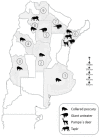Detection of non-tuberculous mycobacteria in native wildlife species at conservation risk of Argentina
- PMID: 38420209
- PMCID: PMC10899436
- DOI: 10.3389/fvets.2024.1346514
Detection of non-tuberculous mycobacteria in native wildlife species at conservation risk of Argentina
Abstract
Introduction: Non-tuberculous Mycobacteria (NTM) are mainly environmental but can cause opportunistic infections and diseases in humans and animals. Livestock and wild animals can be infected with NTM. In Argentina, there are native wild species facing conservation risks, and they are the focus of protection and reintroduction projects designed to preserve biodiversity in various ecoregions. The aim of this study was to report the presence of NTM in samples collected from four endangered native wild species from nine Argentine provinces, as part of their pre-release health assessment.
Methods: A total of 165 samples from giant anteater, peccary, tapir and pampas deer were obtained, these included either bronchoalveolar or endotracheal lavages, or oropharyngeal, nasopharyngeal or tracheal swabs. Bacteriological culture followed by molecular identification and sequencing were performed.
Results: A total of 27 NTM were detected, including Mycobacterium avium subsp. hominissuis, M. intracellulare, M. terrae, M. gordonense, M. kumamotonense, M. fortuitum, M. saskatchewanense, and M. genavense. Results revealed a 16,36% NTM recovery rate, with the giant anteater showing the highest prevalence among the mammals under study.
Discussion: In Argentina, due to extensive production systems, the interaction between domestic and wild species sharing the same environment is frequent, increasing the exposure of all the species to these NTM. In this way, the transmission of infectious agents from one to another is feasible. Moreover, NTMs might interfere with the diagnosis of bovine tuberculosis and paratuberculosis. These findings emphasize the importance of active health surveillance in conservation programs. It highlights the need to address NTM epidemiology in wildlife and its impact on conservation and public health.
Keywords: bacteriological diagnosis; conservation; molecular identification; native wildlife; non-tuberculous mycobacteria.
Copyright © 2024 Barandiaran, Ponce, Piras, Rosas, Peña Martinez and Marfil.
Conflict of interest statement
The authors declare that the research was conducted in the absence of any commercial or financial relationships that could be construed as a potential conflict of interest.
Figures

Similar articles
-
Beyond tuberculosis: Diversity and implications of non-tuberculous mycobacteria at the wildlife-livestock interface.Transbound Emerg Dis. 2022 Sep;69(5):e2978-e2993. doi: 10.1111/tbed.14649. Epub 2022 Jul 13. Transbound Emerg Dis. 2022. PMID: 35780316
-
Detection of Wood Mice (Apodemus sylvaticus) Carrying Non-Tuberculous Mycobacteria Able to Infect Cattle and Interfere with the Diagnosis of Bovine Tuberculosis.Microorganisms. 2020 Mar 6;8(3):374. doi: 10.3390/microorganisms8030374. Microorganisms. 2020. PMID: 32155849 Free PMC article.
-
Non-tuberculous Mycobacteria in South African Wildlife: Neglected Pathogens and Potential Impediments for Bovine Tuberculosis Diagnosis.Front Cell Infect Microbiol. 2017 Jan 30;7:15. doi: 10.3389/fcimb.2017.00015. eCollection 2017. Front Cell Infect Microbiol. 2017. PMID: 28194371 Free PMC article.
-
Zoonotic aspects of Mycobacterium bovis and Mycobacterium avium-intracellulare complex (MAC).Vet Res. 2005 May-Jun;36(3):411-36. doi: 10.1051/vetres:2005001. Vet Res. 2005. PMID: 15845232 Review.
-
[Non tuberculous mycobacterial diseases].Ann Pathol. 2003 Jun;23(3):216-35. Ann Pathol. 2003. PMID: 12909825 Review. French.
References
LinkOut - more resources
Full Text Sources

